By BI Xiaojun
Institute of High Energy Physics, CAS
Dark matter is a type of invisible matter discovered by astronomers when observing the universe. The word “dark” refers to the mysterious fact that no electromagnetic radiation can be observed from this matter. As we know, the electromagnetic waves of different wavelengths are the medium on which astronomers rely to observe the universe. Figure 1 illustrates the spectrum of electromagnetic radiations by wavelength: from radio waves on the left, which are of the longest wavelengths, to microwaves, infrared radiation, visible lights, to radiations of shorter wavelengths including ultraviolet, X-ray, and gamma rays, energy increases in inverse proportion to wavelengths. Modern astronomical observational instruments are developing rapidly, and scientists have obtained powerful instruments for observation in all wavelength bands. However, none of these refined astronomical instruments has ever detected any electromagnetic radiation from this invisible existence, and hence it was named “dark” matter.
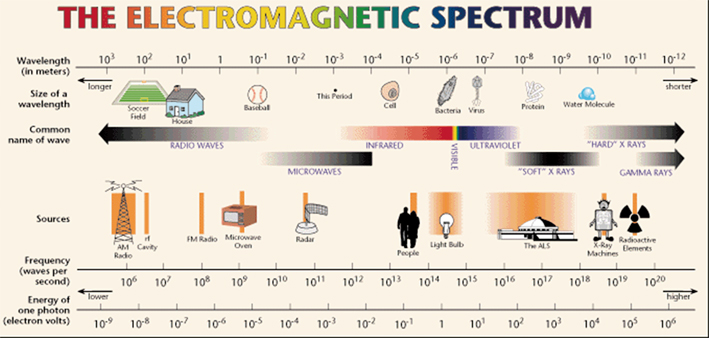
Figure 1. Electromagnetic radiations of different wavelengths. (Credit: NASA)
This said, one might wonder how dark matter was even discovered by human beings. Before looking at the case of dark matter, let’s first get some clues from the discovery of Neptune in our solar system. Since Newton uncovered the law of universal gravitation, astronomers have successfully explained the orbits of most planets (Figure 2). However, this physical law failed to explain the trajectory of Uranus satisfactorily. Its motion is significantly different from what the law of universal gravitation would predict. To explain this discrepancy, French astronomer Urbain Le Verrier and British astronomer John Couch Adams suspected that there should still exist a planet in the solar system that had not yet been identified, and the gravitation from this unknown planet may have pulled Uranus to deviate from its “original” orbit. Following their prophecy, Johann Gottfried Galle successfully brought to light this planet, i.e. Neptune. This story sounds like today’s dark matter. Although no electromagnetic radiation can be detected from dark matter, the influence of its gravity on the movement of other visible matter can be observed – This has helped astronomers derive the existence of dark matter in the universe.
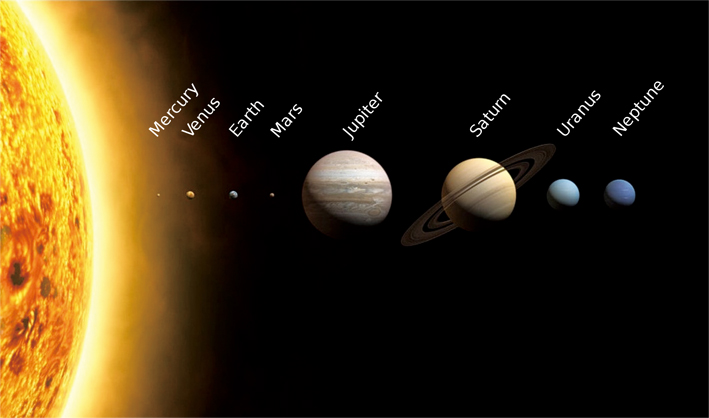
Figure 2: Planetary structure of the solar system. (Credit: Image created by WP, CC - SA - 3.0, https://creativecommons.org/licenses/by-sa/3.0/deed.en)
Let’s take the movement of the Sun as an example. As illustrated in Figure 3, the distance from the Sun to the centre of the Milky Way is about 28,000 light years, whilst it takes the Sun 230 million years to revolve around the centre. We know the centripetal force, which is needed to fix the Sun on such a circular orbit, should be equal to the gravitational pull from the matter within its orbit. From some simple calculation, we can obtain that the generation of such a centripetal force requires a collective mass equivalent to about 100 billion times the mass of the Sun (1.0x1011 MSun) within the solar orbit; while the observed mass of the stars and gases within this domain is merely about one billion solar mass (1.0x109 MSun). Obviously, a large amount of “missing” matter has contributed to the much stronger gravitation that has maintained the much faster revolving velocity of the Sun. Hence similar to the previously mentioned reasoning that has concluded the existence of Neptune outside Uranus, we can infer that without this large, invisible mass, the centripetal force would be much weaker, and the Sun’s revolving velocity would be much smaller, consequently.
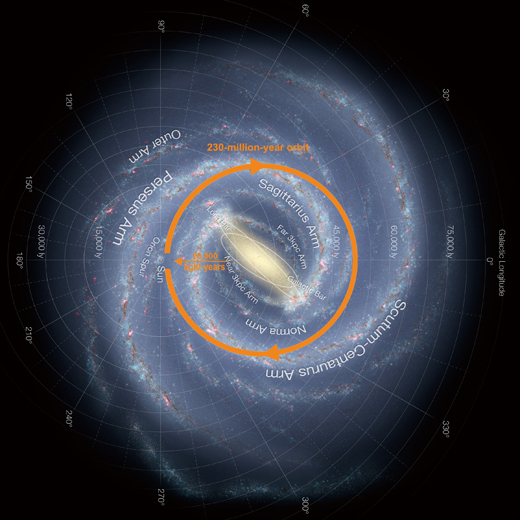
Figure 3: Parameters of the Sun rotating around the Milky Way. (Credit: Image based on an artist’s impression of the Milky Way by NASA/JPL-Caltech/ESO/R. Hurt)
Figure 4 shows the variation in the velocity at which the stars in a galaxy called M33 revolve around the galactic centre as a function of their distance from the latter. The upper curve denotes the observed velocity whilst the lower the prediction based on the observed matter. As we can see, there exists a clear difference between the two curves, i.e. the actual measurements are much larger than the calculated results, indicating that some invisible matter has increased the gravitational force. This represents the most direct observational evidence that has helped astronomers speculate on the existence of dark matter.
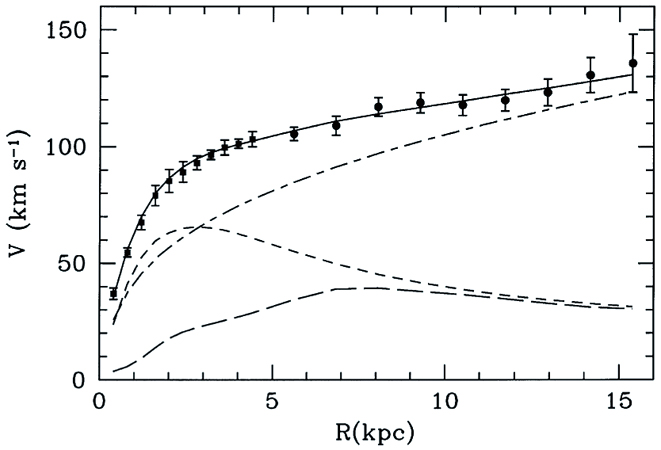
Figure 4: The rotation curve for the spiral galaxy M33. (Extracted and adapted from E. Corbelli and P. Salucci, “The extended rotation curve and the dark matter halo of M33”, Mon. Not. R. Astron. Soc. 311 (2000) 441)
According to the velocities of the revolution at different distances, the distribution of dark matter can be estimated, and hence we can obtain the distribution of mass in the Milky Way (Figure 5). As it is illustrated in Figure 5, most of the stars in our Milky Way are distributed in a thin disc, which is the galactic disc we are familiar with. The huge spherical structure surrounding the disc, composed of dark matter, is called a dark matter “halo.”
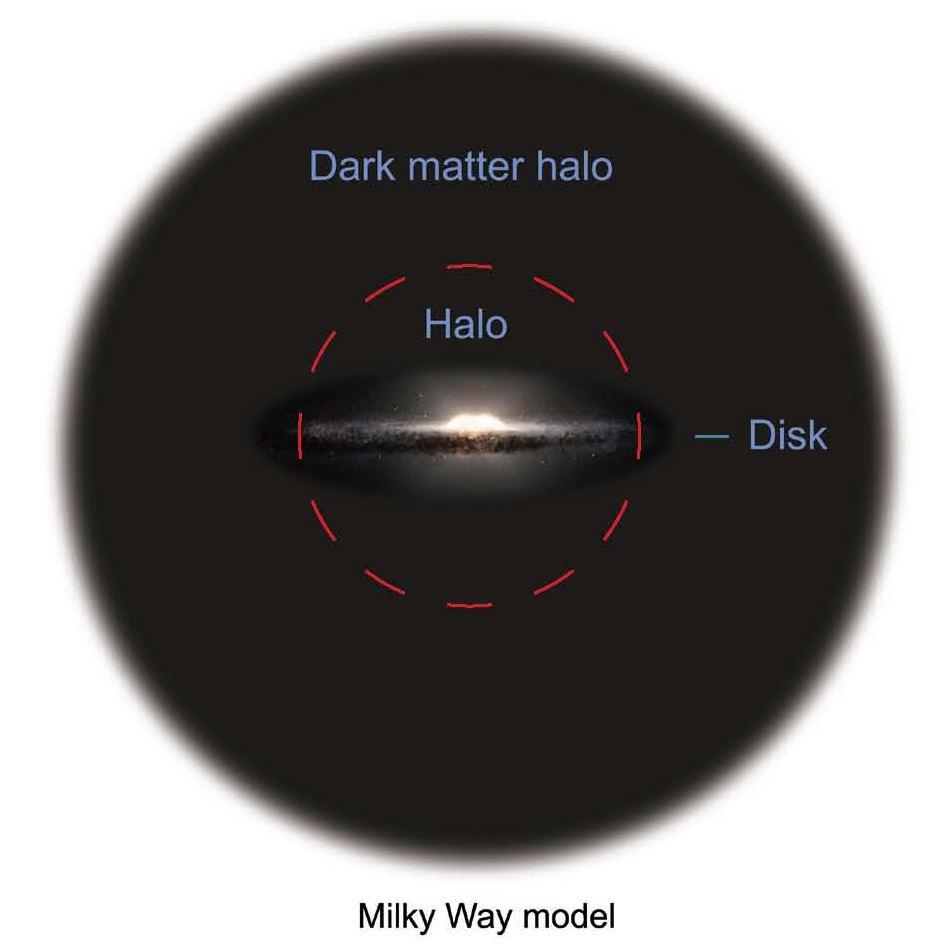
Figure 5: Mass distribution of the Milky Way: Ordinary stars are distributed in the Galactic disc, while dark matter forms a huge halo-like structure, which is nearly spherically symmetrical, called dark matter halo. (Credit: Image based on an artist’s impression of the central bulge of the Milky Way by ESO/NASA/JPL-Caltech/M. Kornmesser/R. Hurt)
The above paragraph recollects how scientists have determined the existence of “missing” matter in the universe from the revolving velocity of stars in galaxies. This represents the most direct observational evidence for the existence of dark matter. There are many other astronomical observations, all of which confirm the existence of dark matter. For example, the distribution of hot gases in galaxy clusters, gravitational lensing caused by galaxy clusters, and the observation of the cosmic microwave background, etc., all demonstrate the existence of dark matter at a large dimension in the cosmos. Nowadays, astronomers have established a “standard cosmological model,” in which the universe consists of ~68% dark energy, ~27% dark matter, and ~5% ordinary matter. This model can successfully explain almost all the cosmological observations so far, and can be regarded as the latest human understanding of the universe.
Although a large number of astronomical observations have confirmed the existence of dark matter, unlike the process of discovering Neptune, however, we have not yet directly observed dark matter despite many years of great efforts. What kind of substance is dark matter? It is generally accepted that it should be composed of a completely new type of particles, which differ from any of the known ones that make up the matter surrounding us. What we know now is that they are some stable, uncharged, slow-moving particles. However, their specific properties, such as mass and the nature of their mutual interactions, cannot be determined. Physicists have also proposed many models to explain the phenomenon of dark matter. Yet, because of the absence of direct observational evidence, the properties of dark matter particles vary greatly across different models. Among them, one is called “weakly interacting massive particles (WIMP),” which is currently the most studied. Initially, this model was proposed to explain “how is dark matter generated in the early universe.” This model states that dark matter should have emerged at a very early stage of cosmos evolution from high-temperature and high-density matter, just as ordinary matter. In other words, its origin is the same as ordinary matter. If this assumption holds, researchers found out, when the mass and interaction strength of dark matter are similar to the canonical weak interaction as we already know, its density should be consistent with the measurement. Because this model can explain the abundance of dark matter we observe in the universe, it has received great attention. At present, most of the detection experiments of dark matter are targeting to WIMP signals.
Currently, there are three primary methods to detect dark matter (Figure 6). To explore dark matter, it is critical to detect the interaction between dark matter particles and normal particles. Only by analysing the detected signals, can we understand what the “unknown interaction” is as shown in Figure 6. This interaction manifests in three directions. From the right to the left, by accelerating ordinary particles to a certain high energy, we can produce dark matter particles in collisions – in other words, we can detect dark matter particles via collider search, just as how scientists use the Large Hadron Collider (LHC) to explore dark matter at the European Organization for Nuclear Research. In the direction from the top to the bottom, dark matter particles can be elastically scattered off from normal particles, and the signals generated by such a scattering can be picked up to find dark matter directly. In the direction from the left to the right, two dark matter particles can collide with each other and annihilate, producing a pair of ordinary particles. The searching of such annihilation products so as to identify dark matter particles makes an indirect method of detection.
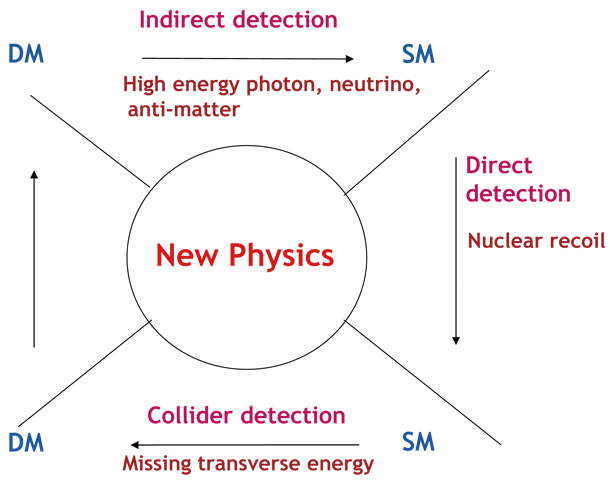
Figure 6: Three methods of detecting dark matter.
Direct detection of dark matter means to find out the signals left behind by the dark matter particles themselves when they hit the detector. Usually, the signals from the scattering of dark matter are very weak while the noise of cosmic rays is much larger. Therefore, in order to detect such a weak signal, it is necessary to place the detector in a deep underground laboratory so as to shield the noise of cosmic rays. In 2010, the Jinping Underground Laboratory was founded in Sichuan, China. It is the deepest underground laboratory with the lowest cosmic ray noise in the world, and hence extremely suitable for experiments of detecting dark matter. Currently, two direct detection experiments are ongoing in Jinping Underground Laboratory. However, although human beings have been trying to directly detect dark matter for about 30 years, with greatly improving experiment sensitivity, unfortunately, no convincing signal of dark matter scattering has been found so far.
As shown in Figure 7, when two dark matter particles collide with each other, they “annihilate” and turn into quark, lepton and other particles that we are familiar with. These unstable particles will rapidly decay and turn into more stable particles, such as positrons and electrons, protons and antiprotons, neutrinos, and photons, etc. Indirect detection of dark matter is to find this silent matter by searching for signals from these annihilation products in the cosmic rays. Indirect detection experiments are usually deployed either on the ground or in space. Ground experiments are suitable for detecting gamma rays and neutrinos generated by the annihilation of dark matter particles. However, these charged particles react quickly with the atmosphere, and hence are not particularly suitable for detecting from the ground. Normally, for detecting cleaner signals corresponding to the annihilation of dark matter particles, experiments in space, including experiments aboard satellites and the space station, are needed. The ongoing space experiments are as follows. The Fermi satellite is a gamma-ray detection satellite launched by the United States to find gamma-ray signals resulted from the annihilation of dark matter particles. It was launched in 2008, and has been in operation for around 10 years, achieving a lot of scientific results. Nevertheless, it has not found any signal relevant to the annihilation of dark matter particles, and thus has imposed strict constraints on the properties of dark matter. The other two experiments, i.e. PAMELA satellite-borne experiment and the AMS-02 experiment, which is deployed on the International Space Station, are both set in magnetic fields, and are therefore capable of measuring the electric charges of charged particles. By measuring anti-particles in cosmic rays, such as positrons, antiprotons, etc., the experiments can be utilised to discover the traces of dark matter. The latest experiment is the “Wukong” satellite, namely the Dark Matter Particle Explorer (DAMPE). It was launched by China in 2015, and is designed to search for dark matter by detecting positrons and electrons generated by the annihilation of dark matter particles.
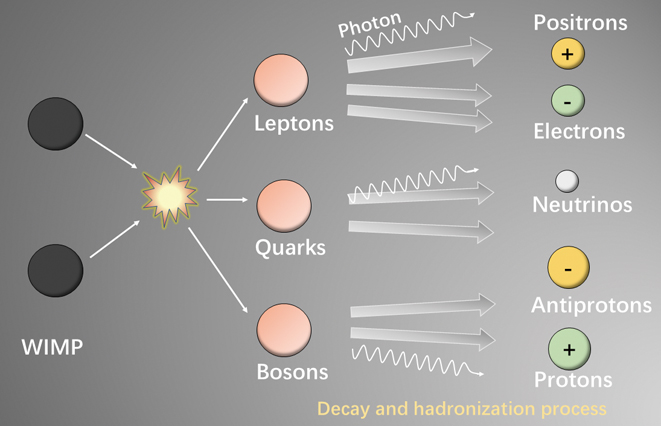
Figure 7: Principle of indirect detection of dark matter. (Image by GAO Linqing and LIN Sujie)
The recent discovery of positron anomaly in cosmic rays represents an important advance in the detection of dark matter. In 2008, the PAMELA satellite found that the recorded counts of positrons were much higher than expected in cosmic rays. This excess has greatly encouraged the scientists, who believe that this may be a signal from the long-sought-after dark matter. Studies reveal that annihilation of dark matter particles can perfectly explain these excessive positrons. Unfortunately, dark matter is not the only interpretation.
Astronomers believe that there exists a type of celestial bodies called “pulsar” in the Milky Way, which is thought to be high-speed rotating neutron stars. These celestial bodies can generate high-energy positron and electron pairs, and radiate them into the Milky Way space. Such signals, traveling to the vicinity of the Earth, can produce excessive positron signals observed in the experiment.

Figure 8: Several dark matter detection experiments, including AMS-02 based on the space station, Fermi Satellite, and Wukong Satellite. [Credit: Image (a) and (b) by courtesy of NASA; Image (c) by DAMPE collaboration]
AMS-02 is a large-scale experimental device initiated by renowned Chinese physicist Samuel Chao Chung Ting, a Nobel laureate, and mounted on the International Space Station. It can more accurately measure the energy spectrum of the positrons and electrons in cosmic rays, hence is able to confirm the observation of PAMELA, extending its conclusion to a larger energy range and higher precision. However, even the results from AMS-02 cannot discern whether the source of the position anomaly is from dark matter or the pulsar. The different curves in Figure 9 represent positrons from various sources, and we can find that all of these curves can explain the data from AMS-02 in the figure. To solve this problem, a larger detector is needed.
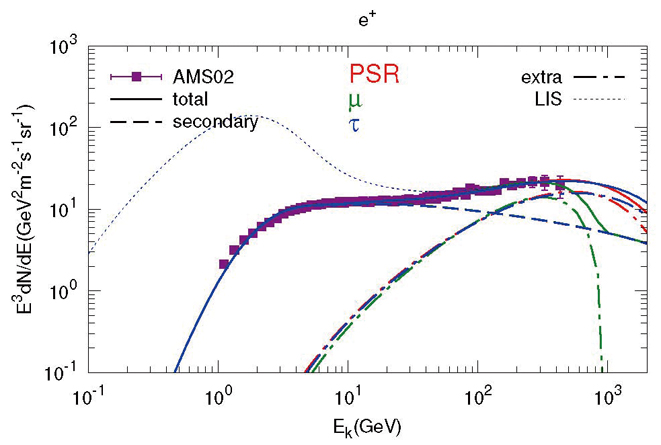
Figure 9: Proportion of positrons, denoted by points, in cosmic rays observed by AMS-02 and the interpretation of different theoretical models, represented by solid lines. (Image extracted from Phys, Rev.D91(2015)063508)
Additionally, the antiproton measurements recently released by AMS-02 could shed some new light. The part of the measurement at the highest energies appear to be inconsistent with the theoretical expectations for cosmic rays, i.e. excessive sources of antiprotons are required to explain this. If this result is confirmed in the future, it would be most likely a sign of dark matter annihilation. However, the current experimental data is not precise enough to confirm this result.
“Wukong” satellite, the dark matter particle detector of China is intended to measure the energy spectrum of cosmic ray positrons and electrons in a higher energy range, to help identify the sources of excessive positrons in the cosmic rays. (Because the “Wukong” detector does not carry a magnetic field, it cannot distinguish between positive and negative charges, and what is actually measured by it is the combined energy spectrum of electrons and positrons, which we named as the electron spectrum.) “Wukong” published its first scientific results (Figure 10) in 2017, presenting the measurement of cosmic ray electron’s spectrum up to 4.6TeV and discovery of a spectral break in fluxes at energies around 0.9 TeV for the first time from space. These results, however, are not enough to confirm the presence of dark matter. Researches at higher energy and higher precision may be needed for searching this special existence. The future cosmic ray experiment HERD, which will be deployed in China’s space station, may make thrilling breakthroughs in this field, providing more clues for the search of dark matter.
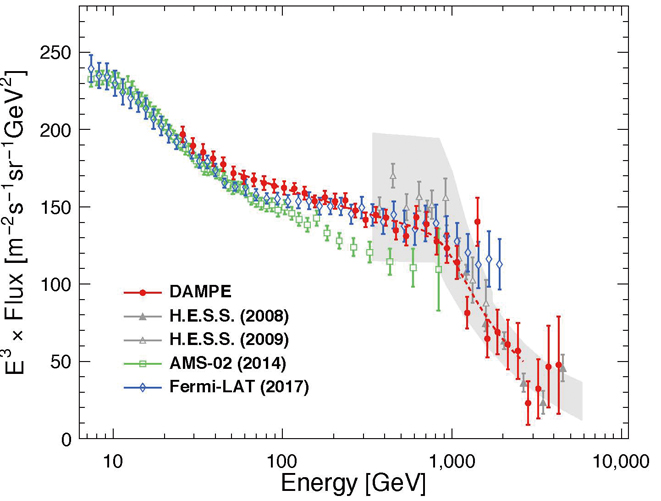
Figure 10: Observations of “Wukong” (i.e. DAMPE) – High-energy electron spectrum. [Image by DAMPE Collaboration, extracted from paper by the team published in Nature 552(2017)63-66)]
To sum up, the issue of dark matter is vital for today’s fundamental physics research, and scientists have never spared any effort in solving this problem. Although the efforts to explore dark matter have made great progress and obtained many scientific research results, yet we do not find defined signals of dark matter while the enigma of dark matter remains unsolved and still confusing people. Chinese scientists, as late comers in this field, have made their own contributions with internationally important results, from various aspects of the research.
(Translated by ZHANG Ling)

